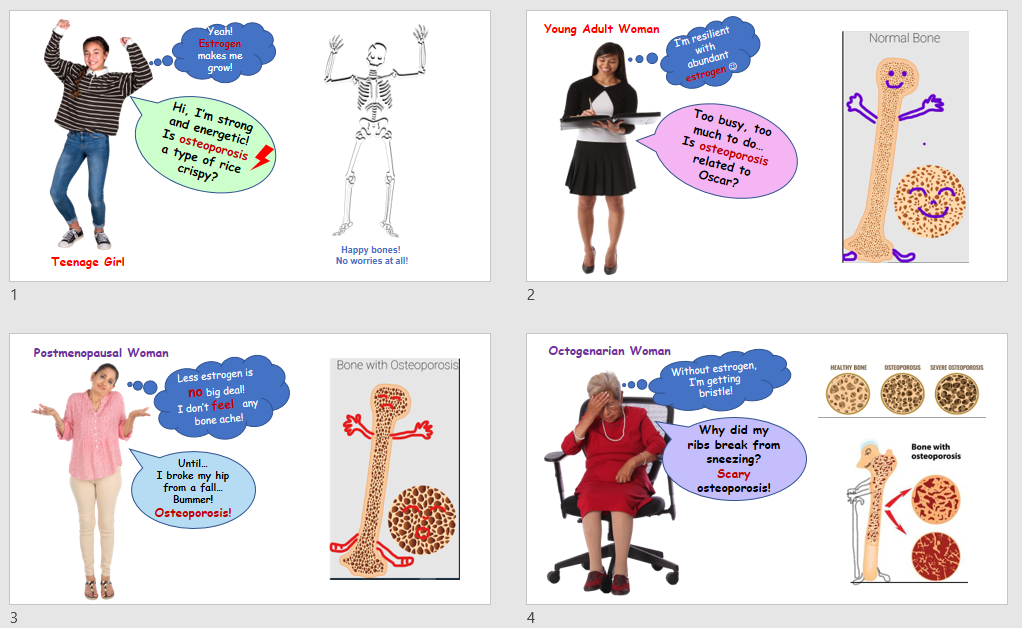
Estrogen, Bone Growth, and Postmenopausal Osteoporosis
Objective and Introduction
My STEAM project is based on the objective “explain how bone development is hormonally regulated”. My research and the comic illustrations are about female sex hormone estrogen and postmenopausal osteoporosis, which include the function of estrogen in female bone development during adolescence, young adulthood, early postmenopausal stage, and female octogenarian in late adulthood. I created color comic PPT slides to illustrate the function of estrogen in bone growth and development of osteoporosis in different developmental stages, and I also illustrated the internal structure of femur bones in these stages with different characteristics.
Research Literature Review
According to Desaix, et.al. (2017), there are four main types of cells in bone tissue: osteocyte, osteoblast, osteogenic cell, and osteoclast. The osteogenic cells are responsible to develop into osteoblasts for bone formation and osteoclasts for bone resorption. Some of the osteoblasts develop into osteocytes that maintain mineral concentration of bone matrix. Bone remodeling is a dynamic and complex metabolic process. The resorption of pre-existing bone by osteoclasts is followed by the formation of new bone by osteoblasts. Bone resorption and deposition are closely coupled, and their balance defines bone mass and quality (Nakamura, et. al., 2007).
According to Nakamura, et.al. (2007), several hormones and transcription factors directly regulate the proliferation and differentiation of osteoblasts and osteoclasts, including growth hormone, thyroxine, sex hormones, calcitriol, parathyroid hormone, and calcitonin. Estrogen, the female sex hormone, is a key hormone in bone remodeling by promoting osteoblastic activity and production of bone matrix of females. Estrogen is also responsible for the growth spurt of girls during adolescence. In addition, estrogen promotes the conversion of the epiphyseal plate to the epiphyseal line and ends the bone growth longitudinally before adulthood (Desaix, et. al., 2017).
Jarvinen, T.L., Kannus, P., and Sievanen H. (2009) argue that the primary function of estrogen is reproduction as a sex hormone, and the packing of mechanically excess mineral into female bones for future reproduction starts from the onset of estrogen secretion at puberty. Accordingly, the unpacking of this reproductive safety deposit at menopause denotes the origin of osteoporosis. The osteoprotective action of estrogen in postmenopausal women decrease significantly when ovaries stop estrogen production. Estrogen deficiency can result in obvious trabecular bone loss and high bone turnover associated with increased osteoclast numbers in females, which often exists in postmenopausal women and leads to osteoporosis, the most common skeletal disorder (Nakamura, et.al., 2007).
Osteoporosis is a bone disease with a common occurrence as the body ages, especially for postmenopausal women, and it is featured by a decrease in bone mass when the rate of bone resorption exceeds the deposition. Histologically, osteoporosis is featured with a reduction in the thickness of compact bone and the number and size of trabeculae in cancellous bone (Desaix, et. al., 2017). According to National Osteoporosis Foundation (NOF, 2021), osteoporosis means “porous bone”. Healthy bone looks like a honeycomb when viewed under a microscope, while osteoporotic bone has bigger holes and space in the honeycomb. Osteoporosis is called a silent disease because patients usually do not feel bone weakening. Most patients were diagnosed from unexpected fracture of bones. Basing on the unitary model of involutional osteoporosis, postmenopausal bone loss due to estrogen withdrawal can be described as Type I osteoporosis (an initial accelerated, transient phase) which is followed by a gradual continuous phase (type II) (Jarvinen, T.L., Kannus, P., & Sievanen, H., 2009).
Conclusion and Suggestions
The mechanisms of estrogen action in mammals are very complicated and beyond this project. I mainly focused on the causal relationships of estrogen, bone remolding, and postmenopausal osteoporosis. Although osteoporosis is an irreversible bone disease related with decreased production of estrogen and aging, it is NOT inevitable.
The fundamental treatment of osteoporosis is prevention starting from childhood, including nutrition and exercise. One should have healthy diet with adequate intake of calcium and vitamin D and live an active lifestyle including regular weight-bearing exercises. These good habit in early life can maximize bone mass before the age of 30 and reduce the risk of osteoporosis (Desaix, et. al., 2017).
References
Desaix, P., Johnson, E., Johnson, J.E., Korol, O., Kruse, D., Poe, B., Wise, J.A., Womble, M. and Young, K.A. (2017). Anatomy and Physiology. Rice University, Houston, TX: OpenStax.
Jarvinen, T.L., Kannus, P., and Sievanen, H. (2009). Estrogen and bone – a reproductive and locomotive perspective. Journal of Bone and Mineral Research. 18(11):1921-1931. https://asbmr.onlinelibrary.wiley.com/doi/full/10.1359/jbmr.2003.18.11.1921
Nakamura, T., Imai, Y., Matsumoto, T., Sato, S., Takeuchi, K, Igarashi, K., Harada, Y, Azuma, Y., Krust, A., Yamaoto, Y., Nishina, H., Takeda, S, Takayanagi, H., Metzger, D., Kanno, J., Takaoka, K., Martin, T.J., Chambon, P., and Kato, S. (2007). Estrogen prevents bone loss via estrogen receptor α and induction of fas ligand in osteoclasts. Cell. 130(5):811-823. https://www.sciencedirect.com/science/article/pii/S0092867407009622 DOI 10.1016/j.cell.2007.07.025
National Osteoporosis Foundation (NOF). (2021). What is osteoporosis and what causes it? Web: https://www.nof.org/patients/what-is-osteoporosis/ Retrieved on July 22, 2021.
